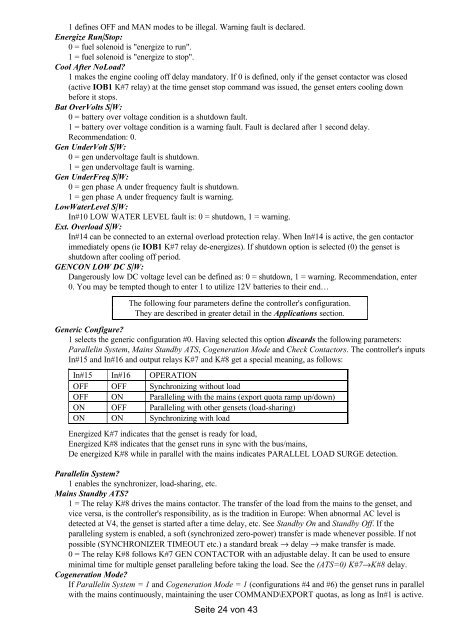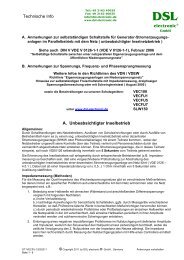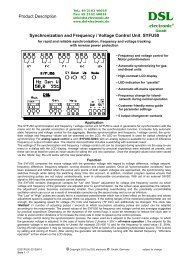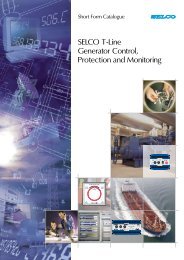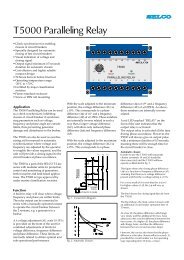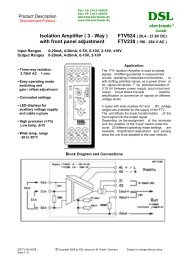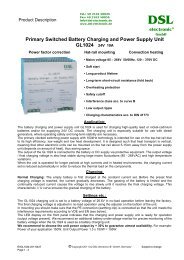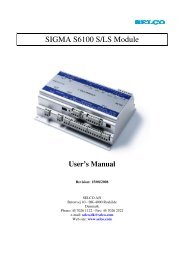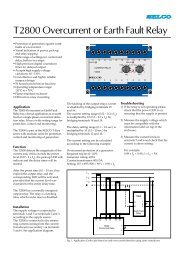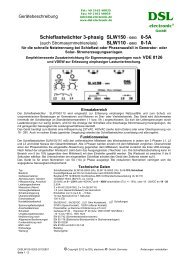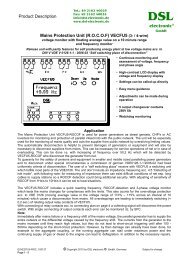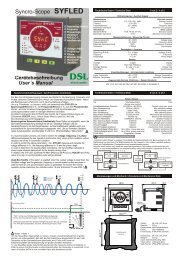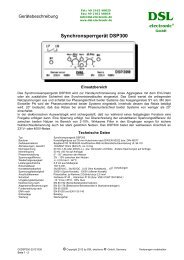Aggregate Control Unit GENCON II pro - DSL electronic ® GmbH
Aggregate Control Unit GENCON II pro - DSL electronic ® GmbH
Aggregate Control Unit GENCON II pro - DSL electronic ® GmbH
You also want an ePaper? Increase the reach of your titles
YUMPU automatically turns print PDFs into web optimized ePapers that Google loves.
1 defines OFF and MAN modes to be illegal. Warning fault is declared.<br />
Energize Run|Stop:<br />
0 = fuel solenoid is "energize to run".<br />
1 = fuel solenoid is "energize to stop".<br />
Cool After NoLoad?<br />
1 makes the engine cooling off delay mandatory. If 0 is defined, only if the genset contactor was closed<br />
(active IOB1 K#7 relay) at the time genset stop command was issued, the genset enters cooling down<br />
before it stops.<br />
Bat OverVolts S|W:<br />
0 = battery over voltage condition is a shutdown fault.<br />
1 = battery over voltage condition is a warning fault. Fault is declared after 1 second delay.<br />
Recommendation: 0.<br />
Gen UnderVolt S|W:<br />
0 = gen undervoltage fault is shutdown.<br />
1 = gen undervoltage fault is warning.<br />
Gen UnderFreq S|W:<br />
0 = gen phase A under frequency fault is shutdown.<br />
1 = gen phase A under frequency fault is warning.<br />
LowWaterLevel S|W:<br />
In#10 LOW WATER LEVEL fault is: 0 = shutdown, 1 = warning.<br />
Ext. Overload S|W:<br />
In#14 can be connected to an external overload <strong>pro</strong>tection relay. When In#14 is active, the gen contactor<br />
immediately opens (ie IOB1 K#7 relay de-energizes). If shutdown option is selected (0) the genset is<br />
shutdown after cooling off period.<br />
<strong>GENCON</strong> LOW DC S|W:<br />
Dangerously low DC voltage level can be defined as: 0 = shutdown, 1 = warning. Recommendation, enter<br />
0. You may be tempted though to enter 1 to utilize 12V batteries to their end…<br />
The following four parameters define the controller's configuration.<br />
They are described in greater detail in the Applications section.<br />
Generic Configure?<br />
1 selects the generic configuration #0. Having selected this option discards the following parameters:<br />
Parallelin System, Mains Standby ATS, Cogeneration Mode and Check Contactors. The controller's inputs<br />
In#15 and In#16 and output relays K#7 and K#8 get a special meaning, as follows:<br />
In#15 In#16 OPERATION<br />
OFF OFF Synchronizing without load<br />
OFF ON Paralleling with the mains (export quota ramp up/down)<br />
ON OFF Paralleling with other gensets (load-sharing)<br />
ON ON Synchronizing with load<br />
Energized K#7 indicates that the genset is ready for load,<br />
Energized K#8 indicates that the genset runs in sync with the bus/mains,<br />
De energized K#8 while in parallel with the mains indicates PARALLEL LOAD SURGE detection.<br />
Parallelin System?<br />
1 enables the synchronizer, load-sharing, etc.<br />
Mains Standby ATS?<br />
1 = The relay K#8 drives the mains contactor. The transfer of the load from the mains to the genset, and<br />
vice versa, is the controller's responsibility, as is the tradition in Europe: When abnormal AC level is<br />
detected at V4, the genset is started after a time delay, etc. See Standby On and Standby Off. If the<br />
paralleling system is enabled, a soft (synchronized zero-power) transfer is made whenever possible. If not<br />
possible (SYNCHRONIZER TIMEOUT etc.) a standard break → delay → make transfer is made.<br />
0 = The relay K#8 follows K#7 GEN CONTACTOR with an adjustable delay. It can be used to ensure<br />
minimal time for multiple genset paralleling before taking the load. See the (ATS=0) K#7→K#8 delay.<br />
Cogeneration Mode?<br />
If Parallelin System = 1 and Cogeneration Mode = 1 (configurations #4 and #6) the genset runs in parallel<br />
with the mains continuously, maintaining the user COMMAND\EXPORT quotas, as long as In#1 is active.<br />
Seite 24 von 43


